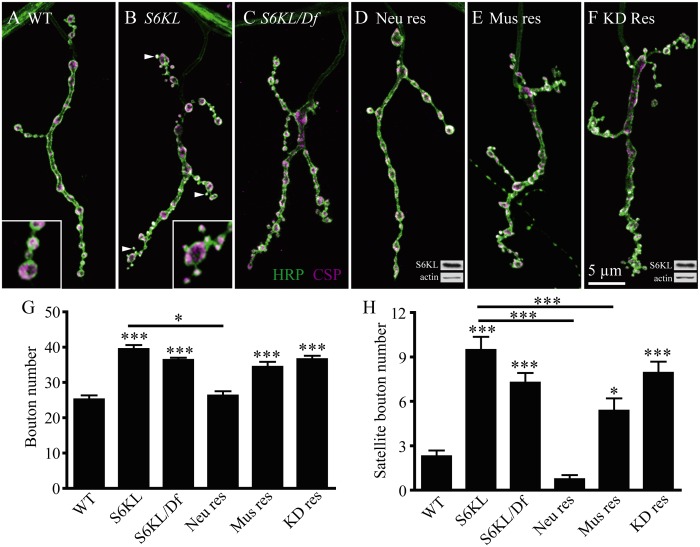Fig 3. Overgrown NMJs in S6KL mutants.
(A–F) Representative NMJ 4 synapses from different genotypes double-stained with anti-HRP recognizing neuronal plasma membrane (green) and an antibody against CSP (magenta), a synaptic vesicle protein. Insets show higher-magnification images of terminal boutons. The genotypes are: (A) Wild type, (B) homozygous S6KL 140 mutants, (C) hemizygous S6KL 140 /Df(1)ED741 mutants, (D) neuronal rescue of S6KL 140 by overexpression of S6KL under the control of elav-Gal4 (S6KL 140 elav-Gal4/S6KL 140 ; UAS-S6KL/+), (E) Muscular rescue of S6KL 140 by overexpression of S6KL under the control of Mhc-Gal4 (S6KL 140; UAS-S6KL/Mhc-Gal4), and (F) Neuronal rescue of S6KL 140 by overexpression of the kinase dead S6KL (S6KLK193Q) under the control of elav-Gal4 (S6KL 140 elav-Gal4/ S6KL 140 ; UAS-S6KL K193Q /+). Satellite boutons are indicated by arrows in B. Insets D and F show Western results of larvae brain extracts using anti-S6KL and anti-actin antibodies. Scale bar, 5 μm. (G, H) Statistical results of the number of total boutons (G) and satellite boutons (H) in different genotypes. n = 17, 19, 15, 16, 19 and 18 NMJs for wild type, S6KL 140, S6KL 140 /Df(1)ED7413, S6KL 140 elav-Gal4/S6KL 140 ; UAS-S6KL/+, S6KL 140; UAS-S6KL/Mhc-Gal4, and S6KL 140 elav-Gal4/S6KL 140 ; UAS-S6KL K193Q /+, respectively. ***p<0.001 by one-way ANOVA with Tukey post hoc test; error bars indicate SEM.

